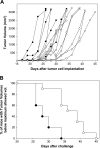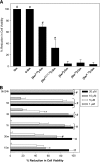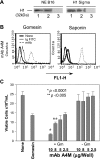Effective topical treatment of subcutaneous murine B16F10-Nex2 melanoma by the antimicrobial peptide gomesin
- PMID: 18231639
- PMCID: PMC2213900
- DOI: 10.1593/neo.07885
Effective topical treatment of subcutaneous murine B16F10-Nex2 melanoma by the antimicrobial peptide gomesin
Abstract
Gomesin is a potent antimicrobial peptide (AMP) isolated from hemocytes of the spider Acanthoscurria gomesiana. The present study aimed at determining whether gomesin exerted antitumor activity in vitro and in vivo. Topical treatment of subcutaneous murine melanoma with gomesin incorporated in a cream base significantly delayed tumor growth. A direct cytotoxicity of gomesin in murine melanoma B16F10-Nex2 cells and several human tumor cell lineages was observed in vitro, with IC(50) values below 5 microM. The beta-hairpin structure of gomesin with disulfide bridges seemed essential for optimal activity. d-Gomesin was equally active. A membrane-permeabilizing activity was suggested, as gomesin bound to the cell membrane and cytoplasmic lactate dehydrogenase was detected extracellularly. At doses causing partial growth of tumor cells, gomesin allowed internalization of macromolecules (immunoglobulins), which increased the cytotoxic effect. The in vivo antitumor effect of gomesin might also involve a cytotoxic effect on endothelial cells because cultured human endothelial cells were killed in vitro at a similar concentration range. This effect represents a novel and potential use for gomesin as a topical agent against unsuccessfully treated intradermal and epithelial skin cancers. To our knowledge, this is the first report on the successful topical use of AMPs in cancer treatment.
Figures







Similar articles
-
Characterization of thimet oligopeptidase and neurolysin activities in B16F10-Nex2 tumor cells and their involvement in angiogenesis and tumor growth.Mol Cancer. 2007 Jul 9;6:44. doi: 10.1186/1476-4598-6-44. Mol Cancer. 2007. PMID: 17620116 Free PMC article.
-
Redesigned Spider Peptide with Improved Antimicrobial and Anticancer Properties.ACS Chem Biol. 2017 Sep 15;12(9):2324-2334. doi: 10.1021/acschembio.7b00459. Epub 2017 Aug 8. ACS Chem Biol. 2017. PMID: 28741926
-
Structure-activity relationship studies of gomesin: importance of the disulfide bridges for conformation, bioactivities, and serum stability.Biopolymers. 2006;84(2):205-18. doi: 10.1002/bip.20396. Biopolymers. 2006. PMID: 16235231
-
Unlocking the Potential of the Antimicrobial Peptide Gomesin: From Discovery and Structure-Activity Relationships to Therapeutic Applications.Int J Mol Sci. 2023 Mar 20;24(6):5893. doi: 10.3390/ijms24065893. Int J Mol Sci. 2023. PMID: 36982972 Free PMC article. Review.
-
The Biological and Biophysical Properties of the Spider Peptide Gomesin.Molecules. 2018 Jul 16;23(7):1733. doi: 10.3390/molecules23071733. Molecules. 2018. PMID: 30012962 Free PMC article. Review.
Cited by
-
From antimicrobial to anticancer peptides. A review.Front Microbiol. 2013 Oct 1;4:294. doi: 10.3389/fmicb.2013.00294. Front Microbiol. 2013. PMID: 24101917 Free PMC article. Review.
-
Anticancer, antimicrobial, and analgesic activities of spider venoms.Toxicol Res (Camb). 2018 Mar 8;7(3):381-395. doi: 10.1039/c8tx00022k. eCollection 2018 May 8. Toxicol Res (Camb). 2018. PMID: 30090588 Free PMC article. Review.
-
Tumor cell membrane-targeting cationic antimicrobial peptides: novel insights into mechanisms of action and therapeutic prospects.Cell Mol Life Sci. 2017 Oct;74(20):3809-3825. doi: 10.1007/s00018-017-2604-z. Epub 2017 Aug 2. Cell Mol Life Sci. 2017. PMID: 28770291 Free PMC article. Review.
-
Helminthes and insects: maladies or therapies.Parasitol Res. 2015 Feb;114(2):359-77. doi: 10.1007/s00436-014-4260-7. Epub 2014 Dec 30. Parasitol Res. 2015. PMID: 25547076 Review.
-
The War on Cancer rages on.Neoplasia. 2009 Dec;11(12):1252-63. doi: 10.1593/neo.91866. Neoplasia. 2009. PMID: 20019833 Free PMC article.
References
-
- Naumov GN, Townson JL, MacDonald IC, Wilson SM, Bramwell VH, Groom AC, Chambers AF. Ineffectiveness of doxorubicin treatment on solitary dormant mammary carcinoma cells or late-developing metastases. Breast Cancer Res Treat. 2003;82:199–206. - PubMed
-
- Gottesman MM. Mechanisms of cancer drug resistance. Ann Rev Med. 2002;53:615–627. - PubMed
-
- Gottesman MM, Ling V. The molecular basis of multidrug resistance in cancer: the early years of P-glycoprotein research. FEBS Lett. 2006;580:998–1009. - PubMed
-
- Folkman J. Angiogenesis. Ann Rev Med. 2006;57:1–18. - PubMed
-
- Ferrara N, Kerbel RS. Angiogenesis as a therapeutic target. Nature. 2005;438:967–974. - PubMed
Publication types
MeSH terms
Substances
LinkOut - more resources
Full Text Sources
Medical
